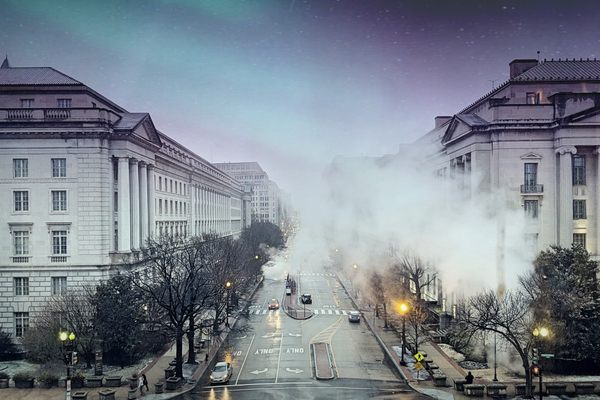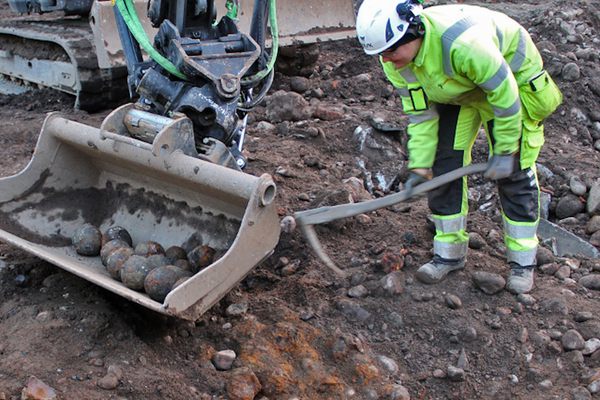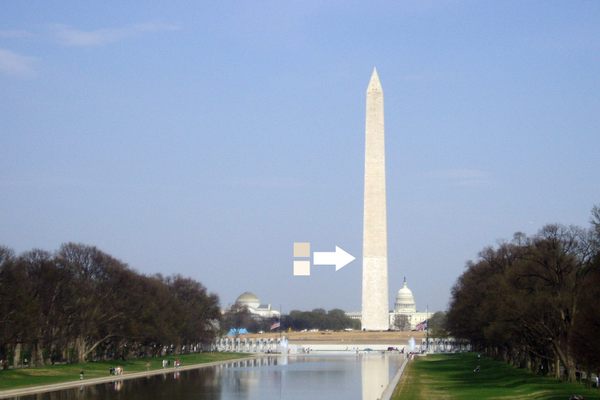Explore the Geologic History of D.C. Through This Walking Tour
“These sites are reminders of American history, but they’re also part of the Earth’s history.”

While using the bathroom in one of Washington, D.C.’s congressional office buildings, if you let your eyes wander to the stall dividers, you might notice something that transcends the political moment by a couple million years: fossils engraved on the glossy limestone, ancient shells and exoskeletons left behind by animals of a prehistoric Earth.
When the writer Lily Strelich was a congressional intern, she spent a lot of time admiring the hidden-in-plain-sight fossils that speckle the buildings. This week, she wrote a Self-Guided Tour of the Geology of D.C. Buildings for Eos, a publication of the American Geophysical Union. The tour provides a 2.5-mile walking tour around the National Mall, with 11 stops highlighting a small piece of the geologic story of America’s capital city.
Strelich, who studied geology in college, wanted to spread her love of rocks to people who aren’t used to noticing them. “The idea that there’s a sort of geologic landscape in this urban environment is really wonderful to me,” she says.
One of Strelich’s favorite stops on the tour is the Smithsonian Castle, built from Seneca red sandstone, quarried 20 miles north of the city. Its rusty red color comes from oxidized iron mixed into the rock—it’s literally rusty.
A lot of the geologic materials which make up and adorn the city are brought in from elsewhere, making for a rich mix of local and imported specimens. Strelich says she may have creeped out a guard or two while crawling around looking for nautiloid fossils on the floor of the National Gallery of Art, which is made of Tennessee limestone. “I’ve been to that museum so many times, but I’ve had never paid attention to the fossils,” she says. “It’s almost like there are two museums for you: the art and the rocks.”

The geologic tour includes the old Lockkeeper’s House, which was once at the end of the Chesapeake & Ohio Canal system, instrumental to moving heavy rocks up the Potomac River in order to build the capital. Bentley says the Potomac bluestone rocks on this building are ancient. They pre-exist the supercontinent Pangea and got metamorphosed in the early days of the Appalachian Mountains.
Stop four on the tour are the Capitol Gatehouses and Gateposts. These historic buildings are comprised of Aquia Creek sandstone, made by sand carried by rivers pouring into the young Atlantic Ocean after the breakup of Pangea.
Callan Bentley, a geology teacher at Northern Virginia Community College, helped Strelich develop the tour and has experience creating local field trips to sites of geological interest. When he looks at the D.C.-area landscape, he’s most interested in what’s underneath the trees and buildings. “We’ve got a lot of plants and buildings on top of our rocks, but where the rocks are exposed, they tell a pretty extraordinary tale,” he says.
Bentley says D.C. is at the epicenter of the diverse Atlantic geological area, containing pieces of two former supercontinents, and a variety of metamorphic and sedimentary rocks of different sizes, ages, and characteristics. “Each of these tells its own story and when you put them all together, you get this epic tale that spans a little over a billion years of geologic time,” he says. He adds that D.C. geology is defined by something called the Wilson Cycle, a model which says that geologic processes repeat themselves indefinitely.
“It’s an essential principle of geology. We’re constantly changing, but we’re basically playing by the same rules,” says Bentley. “We don’t have to make up brand new rules for every single moment in geologic time. We can look at the present and apply it to our understanding of the past and to predict the future.”
Whatever one’s political inclination, Strelich thinks this tour will enhance the experience of visiting the city. “These sites are reminders of American history, but they’re also part of the Earth’s history,” she says, “our larger shared history.”


































Follow us on Twitter to get the latest on the world's hidden wonders.
Like us on Facebook to get the latest on the world's hidden wonders.
Follow us on Twitter Like us on Facebook